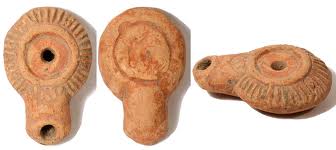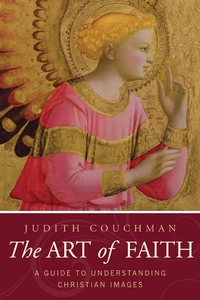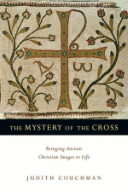museum attached to a small Christian university. The docent fascinated our group with ancient artifacts, handing them out so we could touch Scripture’s history. I remember examining a clay pot and holding facsimiles of iron nails used for a Roman crucifixion. The spike-sized nails evoked murmurs as they passed from one person to another, but the object that stirred me most slipped into my hands quietly. It’s so small, I thought. The archaic oil lamp, in remarkably good condition, fit in the palm of my hand.
While reading biblical metaphors about oil lamps, or looking at them in museum catalogs, I’d imagined vessels much larger than this. How did a traveler find his way in the darkness with such a tiny, fluttering flame? How did a mother sweep a floor, straighten the house, or snuggle her children into bed? Obviously, these people knew something more than I did—something wise and almost mysterious—about navigating the night.
Later I thought about Old and New Testament references to lamp light. The Israelite psalmist wrote, “Your word is a lamp to my feet and a light for my path” (Ps. 119:105). An ancient proverb claimed, “The light of the righteous shines brightly, but the lamp of the wicked is snuffed out” (Pr. 20:2). While telling the parable about a woman who lost a coin, Jesus asked, “Does she not light a lamp, sweep the house and search carefully until she finds it?” (Lk. 15:8). Most likely, early Christians understood lamp metaphors in practical ways unfamiliar to me. Every day in shadowy rooms, every evening when the sun descended, they lit oil lamps to illumine shades of darkness.
Carving Out Religious Beliefs
As far back as 3500 B.C., oil lamps served as light sources
for civilizations. However, pottery lamps didn’t flourish until about the eighth or seventh century B.C. These simple, wheel-thrown vessels looked like saucers with turned-up edges, with wicks immersed in olive or vegetable oil and draped over the edges. Later the Greeks innovated by enclosing their lamps and adding spouts, handles, and glazes. During the Hellenistic Age and the early centuries of Christianity, lamps created from molds of clay, stone, or plaster dispersed as much as those shaped on pottery wheels.
Aside from increasing production, molds allowed elaborate designs and three-dimensional figures to appear on lamps created for religious ceremonies or wealthy patrons. At the same time, factories mass produced undecorated lamps, either for humble homes or Jews whose religious tradition prohibited graven images. Pottery makers stamped the bottom of these popular firmalampen with the factory owner’s name. Archaeologists today still unearth these stamped lamps throughout the former Roman Empire, while digging up settlements and burial sites.
The Herodian lamp—named after the reign of Herod the Great—populated Palestine’s hill country and cities from about 50 B.C. to 70 A.D. It’s possible that this lamp evolved in Jerusalem or a nearby location. To create the Herodian lamp, potters shaped a circular, wheel-made body with a wide spout applied by hand. A hole in the middle of the base accommodated filling the lamp with oil, and the spout’s opening held the wick and its flame.
Jesus probably envisioned this lamp when he told the parable about ten maidens waiting for the bridegroom (Mt. 25:1-12), or explained to his listeners, “You are the light of the world. A city on a hill cannot be hidden. Neither do people light a lamp and put it under a bowl. Instead they put it on its stand, and it gives light to everyone in the house” (5:14-15). Obviously, Jesus referred to the spiritual light that identified people as his followers. Still, almost 2,000 years later, actual oil lamps have helped archaeologists pinpoint ancient Christian activity.
In late antiquity, oils lamps often expressed religious beliefs with symbols or inscriptions. Pottery workshops in Cyprus, Greece, Egypt, North Africa, and Syria-Palestine manufactured lamps portraying pagan gods, Jewish menorahs, and Christian crosses. When archaeologists recover lamps with crosses, they tentatively assume a Christian community resided nearby. For example, researchers discovered lamps with crosses in an ancient funerary complex at Tel el-Fûl, north of Jerusalem. The crosses indicated that Christians settled in that area 1,600 years ago.
Lamps with crosses flooded the Roman Empire in the fourth and fifth centuries, after Christianity became the religion of emperors. Constantine’s monogram of the cross was a favorite symbol, either stamped on a lamp’s body or extended as the handle. Art historians theorize that these crosses symbolized the banishment of spiritual darkness. It’s an apt metaphor. As early Christians held out their lamps and stepped carefully into the darkness, they could see crosses guiding them. Literally, the sign of the cross was a light for their paths. But even more, Christ’s cross shed light on their world’s spiritually dark places.
Shining Into a Dark World
“The mystery of the cross shines bright,” wrote the Bishop of Poitiers in the sixth century. Listening to the newscasts, we might wonder about the veracity of that long-ago claim. The world seems full of so much darkness. But in our frustration, we can recall early Christians carrying their oil lamps, following the flickering cross-flames before them, casting light on their paths with each footfall. Perhaps they modeled how we can shed light into our world: not with bonfire ideas that blast into the darkness and eventually fade into cinders, but by faithfully inching along in the world’s darkness, extending the light of the cross. “People living in darkness [would see] a great light; on those living in the land of the shadow of death a light [would dawn]” (Mt. 4:16). They would see the accumulated light of the cross.
A few years ago I purchased an inexpensive replica of an oil lamp from fifth-century Alexandria. The lamp sits on my desk and its imprinted cross points at me while I work. It reminds me of the
lamp-light promises of Scripture. I want to believe the cross can shine light into any darkness. I need to light a lamp.
How do you need to light a lamp?
Read more about cross images in Judith Couchman’s book, The Mystery of the Cross, published by InterVarsity Press. Available at amazon.com in paperback and Kindle.

 RSS Feed
RSS Feed



